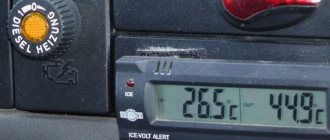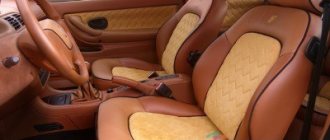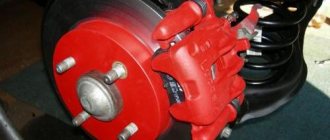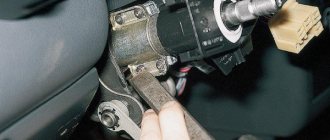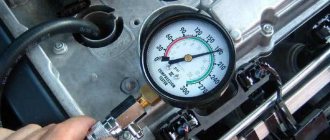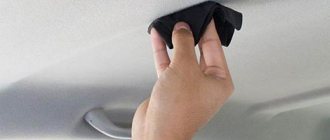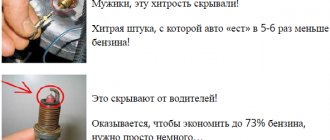For those who like to travel off-road or for summer residents, the main obstacle to movement is the inability of the car to move due to mud, snow, and ice. When standard traction control systems ASR and anti-lock ABS do not help, many craftsmen, in order to improve the cross-country ability and stability of the car on the road, make chains or anti-skid bracelets with their own hands and install them on the wheels. Currently, it is absolutely not necessary to be inventive - manufacturers of auto accessories have “taken into their own hands” the production of bracelets and snow chains, greatly improving their design and making the process of installing and removing them from wheels more convenient.
Use of soft chains
You can resort to a more gentle option, with which you can increase the cross-country ability of your vehicle. We are talking about using rubber or plastic chains. Do-it-yourself anti-skid bracelets in such a situation will have weaker off-road parameters. However, the destructive wear of tires, suspension, and transmission can be avoided. In addition, the speed of movement will increase (up to 90 km/h), which is also an important factor.
Wheel anti-skid bracelets can be divided into two categories. They can be soft or hard. Both options are longitudinal cables or chains (two pieces), which are tensioned around the circumference of the wheel. Cross chains or lugs made of plastic or rubber should be stretched between them.
Do-it-yourself anti-slip devices for wheels
Homemade bracelets are very easy to make; even a beginner can handle the job. First you need to measure the radius of the tire and roughly calculate how much material will be needed. Each wheel should have at least 2 bracelets, but it is better if there are about 4. But everyone decides for themselves what will be more convenient and economical for them. To work you will need:
- chain;
- belt with clip;
- nuts and bolts;
- washers;
- thread and large needle;
- spanners.
The chain will need to be divided into equal pieces, approximately 15 links each. A bolt is attached to the edge of one part using a washer. Next, screw about 8 nuts onto the bolt. Connect the two pieces together using two washers and a nut, which is screwed on the outside of the second part of the chain. The same is done at the other end of the chains. Next, you need to cut a piece of the strap into two parts, about 10 centimeters each. At one end there will be a buckle that will need to be pushed through the bolts, thereby forming a loop. It should be carefully stitched with a thread and a needle in several rows. The strap is attached on the other side in the same way.
Homemade bracelets
If you have a good imagination and a variety of components, you can make an individual version of the traction control device. In terms of reliability and efficiency, it will not be inferior to purchased ones. It will take a little time to make them.
Car owners note that when using metal bracelets, the tire quickly deteriorates. This happens, but only if you use this device constantly. Using such bracelets on a flat surface is prohibited, otherwise the tires can deteriorate very quickly. The same applies to anti-slip chains. If you exceed the permissible speed limit of the vehicle, the bracelet can become detached and fly off, as well as scratch the car at high speed.
What kind of chains can there be?
The crossbars can be made in the form of a ladder, a diamond or a honeycomb. Each of these options has positive and negative aspects. The ladder is characterized by improved rowing capabilities. It is better to resort to it if you need to overcome a muddy section of the road. However, you should be aware that such anti-skid bracelets can cause the wheel to become stuck. Therefore, the ride should be “pull-in”. The driver may encounter other problems. The car will have poor lateral stability. The tires will begin to wear out faster. The gearbox and steering will be subject to more severe shock loads
Wheel anti-skid bracelets with a honeycomb pattern will cause less damage to the main components of the vehicle. The tires will also last longer. Compared to a ladder, such patterns can provide better lateral stability. Constant contact with the surface will also be obtained.
Characteristic
There are different options for anti-skid bracelets:
- for passenger cars (one row of chains is enough for them);
- for medium vehicles (thicker components and two rows of chains are used);
- for large vehicles (trucks and buses are already equipped with the largest products with thick chains in 2-3 rows).
They are convenient to use for trips when off-roading takes up only a small part of the road. It’s good to carry with you in case of an emergency, when a sudden change in weather may cause the road to wash out or a lot of snow to fall.
Advantages
Anti-skid bracelets have undoubted advantages compared to other anti-slip devices:
- they provide good traction on the road with snow or mud;
- you can easily and quickly put them on the wheels yourself and then remove them (this is convenient, especially in areas with unstable winter weather);
- they are not as harmful to tires as chains;
- Several pieces of such devices will give the wheel high maneuverability. You can remove the bracelets from other wheels (or take them out of the trunk) and install them on the stuck wheel;
- if this universal means breaks, it does not harm the car in any way;
- if one bracelet breaks, the others will support its work;
- take up less space, are easier to clean and store;
- they are cheaper than chains;
- It’s quite affordable to make them yourself, saving your budget even more.
Flaws
This device is not ideal, but it is still often used.
The negative characteristics of such bracelets include:
- If they are not fastened carefully, they can come unfastened, and it is not a fact that you will immediately notice the loss.
- probability of breakage;
- influence tire wear in their own way (but there are soft options that are more gentle);
- speed limit;
- to achieve the same traction as chains, you need to put 5-6 pieces of these devices on the wheel.
According to the structure of the manufacturing material, wheel chains are divided into hard and soft.
Soft chains
This option is made from materials that are soft in structure - rubber, plastic, polyurethane.
Such rubber products help to slip in urban conditions and with slight ice, but they are not suitable for severe off-road conditions. To provide grip on the road, they have small spikes, and to give strength, such devices are reinforced.
Using them, you can drive at speeds of up to 80 km/h. They do not spoil rubber and are silent.
Hard chains
They are made from metal - steel, aluminum, titanium, as well as their alloys. The material is strong, which is why such devices are called rigid. The strength of this product is influenced by the type of metal or alloy, as well as the parameters of the links (fraction, thickness). It is worth noting: the larger the link, the higher the cross-country ability.
Cross-country ability is significantly increased in the presence of snowdrifts, mud, and ice. However, the speed when using such iron devices drops to 50 km/h.
Features of hard and soft snow chains
It is not possible to definitively answer which chains are preferable. Each has its own advantages in certain conditions. Therefore, there is no universal option. Rigid chains are best suited for full off-road use. Due to their more pronounced rowing abilities, they will allow you to overcome a difficult section, encountering fewer difficulties.
If you decide to make soft anti-skid bracelets with your own hands (photos of such structures can be seen as you read the review), then you should understand that you cannot use them to tackle off-road conditions. But such systems will help overcome difficult areas. The advantages of this option are that plastic or rubber chains can be removed as soon as a difficult section has been passed. Accordingly, further movement will occur at a higher speed, without the risk of harming the tires or transmission with steering.
When choosing rigid chains, attention should be paid to the size and cross-section of the links. The larger they are, the better the rowing capabilities will be. But the wear and tear on tires, gearbox and steering will increase noticeably. Links with a square cross-section also help improve rowing performance.
Selection of ready-made bracelets
Choosing ready-made bracelets is easy. Available for sale, they are divided into three size categories: small (for cars), medium (for minibuses and SUVs) and large (for trucks). In order not to be mistaken in size, remember the width of the tire tread of your car, measure and compare the length of the bracelet chains with it. The length of the chains should be approximately 5 cm greater than the tread width. Assess the reliability of fastening the belts to the chains. The fastening of the belts must necessarily overlap, and threads made from natural raw materials should not be used for stitching, since in such conditions they will quickly rot. The stitching should be frequent, in several rows (necessarily with nylon threads). The joints of the chain links must certainly be welded or soldered with copper. Electroplating on these chains is not necessary, as it will still wear off after using the bracelet a few times. Along with steel chain bracelets, there are devices in the form of plastic clamps and rubber tubes, but they are not popular among our car enthusiasts. Since our drivers must have everything iron-clad.
Anti-slip bracelets are placed on car wheels to transform a road tire into a wheel for overcoming off-road conditions, snow crust, ice and swampy terrain. As a result of installing the devices, the tread acquires high cross-country properties.
The design of the products consists of chain links, self-tightening locks and straps, which are fastened through threading into disc holes.
Advantages of anti-slip bracelets
Compared to snow chains, bracelets do not require preliminary installation to the off-road site. They put on pretty quickly in the right place.
Such products are easier to manufacture, they require fewer components, and therefore cost less than similar devices.
The reliability and effectiveness of bracelets has already been tested by several generations of car enthusiasts.
Making anti-skid bracelets from a metal chain
The process of making snow bracelets with your own hands is not that complicated. To do this, you will need the following components per product:
- chain for 215 rubber - two strips of 13-15 links (depending on the chosen manufacturing method);
- M5x50 bolts, two pieces;
- M5 nuts – 16 pcs., as well as two self-locking ones;
- wide washers (body) in the amount of 8 pcs.;
- belt with buckle or self-tightening lock – 1 pc. (can be bought at a hardware store).
The sizes of bolts and nuts can be changed to suit your needs! When selecting a chain, you should ensure that its links are welded together and not soldered. It is necessary to take into account that one wheel will require three sets of the above elements.
Step-by-step instructions on how to make anti-skid bracelets with your own hands are as follows:
How to make chains with your own hands?
Since the cost of such structures is quite high, you can make your own anti-skid bracelets for a VAZ, Gazelle, Niva or other vehicles. The process is not complicated. All the necessary elements can be found in construction stores. It should be understood that homemade designs will be cheaper, and their quality will be in no way inferior to purchased options. And it’s quite easy to find aids.
The easiest way is to make a ladder with your own hands. To do this, you need to measure two sections of the chain so that they are slightly shorter in length than the length characteristic of the wheel circumference. Using S-shaped hooks, cross sections should be secured between them. They should be of equal length, which will slightly exceed the width of the tire.
When making anti-slip bracelets with your own hands for a Gazelle or other vehicle, you need to connect the longitudinal sections to each other. To do this, you should use carabiners. A tension device must be fixed in the middle of each longitudinal section. Its other end is attached to the carabiner using a hook. This device will help you reliably fasten the snow bracelets you made yourself (on a Niva, VAZ or other vehicle) to wheels.
Chains with a diamond pattern are much more difficult to make. But you can cope with such a task if you have the desire and perseverance.
Making a bracelet with your own hands
Under very difficult conditions, up to 6 such products can be installed on each wheel. To avoid slipping, 6 of these homemade devices are enough to install 3 pieces on each drive wheel. Let's see how easy it is to make such a bracelet yourself.
DIY anti-skid bracelets: video
Materials for production
You can begin assembling the device as soon as you buy the necessary components.
In order to make one anti-skid bracelet, you need to stock up on materials:
- chain with short links 5 mm thick (14 links are needed for 205 wheels) - 2 equal pieces;
- bolts 6.5 cm (must pass through the link) - 2 pcs.;
- washers for bolts - 8 pcs.;
- nuts for bolts - 8 pcs.;
- self-locking nuts - 2 pcs.;
- Weight lifting belt with self-tightening buckle.
If the wheels are wider than 205 wheels, then you should purchase a chain with 15–16 links. Galvanized products are desirable. The bolts must withstand heavy loads and have a hardness index of 8.8.
Step-by-step instruction
To assemble an anti-skid bracelet from the above materials, you must complete the following steps:
- Cut a piece of belt with a lock at the end of the required length, wrap it and stitch (or sew with an awl) at the free end so that the resulting loop from the belt can be loosely pulled over the bolt with nuts. The diameter of the nut should be smaller than the washer.
- Seal and stitch the same fold on the remaining piece of belt.
- Place one washer on the bolt and thread it through the outermost link of one piece of chain.
- Add another washer to the bolt, and then tighten the 2 nuts. Tighten tightly with a wrench.
- Add two more nuts for the belt (at some distance from each other) and put the free end of the belt on top with a stitched hem.
- Again the washer, the second piece of chain and the washer.
- Tighten the self-locking nut with a wrench.
- Place a washer on the second bolt and thread the outermost link of the free end of one chain.
- Put on the second washer again, tighten 2 nuts tightly, and after a gap, two more nuts for the width of the belt.
- Put on the fold of a long piece of belt.
- Again, place a washer on the free end of the second bolt, the last link of the free end of the second chain, and place the self-locking nut last.
The bracelet is assembled and ready to use.
Correct installation on wheels
A homemade bracelet is installed in the same way as one purchased at a car service:
- The free end of the belt is threaded through the hole in the disk.
- The rest of the part with the lock is thrown over the wheel.
- The extended end is threaded into the lock and fixed.
Second mounting option
The second method is faster. However, experience and certain skills are required. You should lay out the chains with bracelets on the ground, carefully straightening them out. After this, you will need to drive over them so that about 30 cm remains to the end. Then this long part of the bracelets must be put on the wheel. The chain will need to be fastened from the inside using a hook. All links need to be straightened out. The outer sides will also need to be fastened. After this, the bracelet is tightened using an adjusting cable. This method is optimal if you need to attach hand-made snow bracelets to trucks.
Homemade anti-slip bracelets
Making homemade bracelets or chains is easy. It is enough to measure the circumference of the wheel and select the “pattern” of chain weaving in advance. It is better to take the length of the longitudinal parts of the chains with a reserve - if necessary, they can be easily shortened. To secure the anti-skid bracelet on the wheel, use carabiners. Don’t forget to install threaded ties so that you can securely tension the chain on the wheel. It is also a good idea to make gaskets from an elastic but durable material in the places where the bracelet or chain touches the rims to avoid scratches or deformation. Detailed step-by-step instructions for making car snow bracelets with your own hands can be seen in the following video.
Share with friends on social networks:
Telegram
Which is better, chains or snow bracelets?
Anti-slip bracelets consist of 2 parts of a chain, which are connected in pairs by two belts. One belt has a buckle and the other is loose. It is necessary to put anti-slip on the wheel so that the chain, which forms the lugs, is on the tire tread in 2 rows so that there is a slight gap between the rows of chains. The free end of the belt must be passed through the hole in the wheel rim, then the belt must be tightened and fastened.
A chain or bracelet alone is not enough to improve the vehicle's cross-country ability. The set usually includes 6 bracelets. One set for a vehicle with one drive axle (not all-wheel drive). For cars with all-wheel drive, it is advisable to install bracelets on all wheels. In this case, the cross-country ability will increase significantly.
Who needs ready-made chains, it’s better to order here: Here’s what snow bracelets look like And here’s what snow chains look like
The difference between bracelets and snow chains is that when installing bracelets, you do not need to jack up the car. This is very convenient, as you can even put it on the wheels when the car is already stuck.
Anyone who has 2-3 days of free time and some materials can make a manual tire changing machine with their own hands. To do this, you just need: a welding machine with electrodes, rectangular and round pipes, and a couple of 5 mm thick plates.
As for the effectiveness of using bracelets, they are not inferior to chains. By the way, you should not drive haphazardly through mud or loose snow, even with chains or snow bracelets, because if the car sits on the bottom (the bottom lies on the mud or snow, and the wheels hang), then such improvements in cross-country ability will not help.
